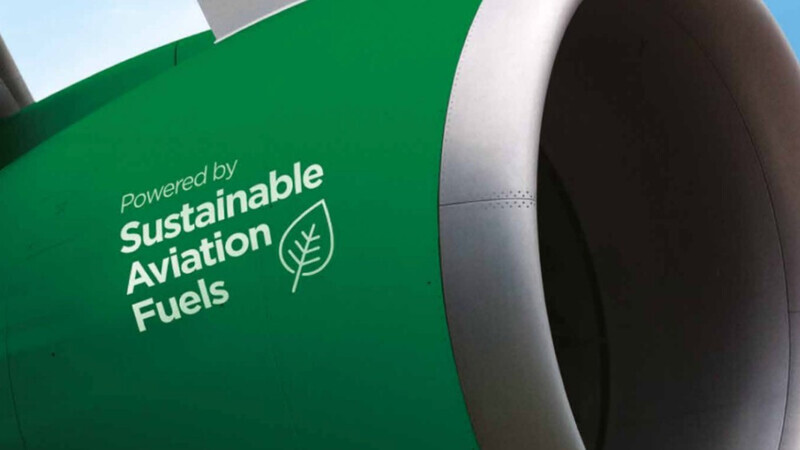
$30 trln in additional investments required to achieve net zero in 8 hard-to-abate sectors
The Net Zero Industry Tracker 2024 estimates that $30 trillion in additional capital will be required across ...

The new sustainable aviation fuel certificate (SAFc) system will allow firms and travelers to claim lower emission benefits when they cover the price premium for sustainable aviation fuel.
In terms of ticket prices, feedback from many of the aviation-customer partners of the World Economic Forum’s Clean Skies for Tomorrow (CST)’s indicates that a 5%-10% increase in airfares would be acceptable, provided this delivers a significant and verifiable decrease in emissions.
Some companies within the CST coalition are already piloting the approach of paying more for SAF, including Alaska Airlines, American Airlines, Deloitte, Deutsche Post DHL Group, Microsoft, BCG, Neste and SkyNRG. In the case of Microsoft, for example, an agreement with Alaska and SkyNRG applies to CO2 emissions from employee travel between Seattle and three Californian airports.
Aviation is one of the world’s most carbon-intensive sectors and one of the hardest to decarbonize. Now, however, a new framework has been developed by a wide range of industry partners to cut emissions by stimulating the use of sustainable aviation fuel (SAF) via a system of certificates.
Developed through the World Economic Forum’s CST initiative, the Sustainable Aviation Fuel Certificate (SAFc) system is a new accounting tool that will allow SAF emissions reductions to be claimed by the traveller if they cover the higher cost of the fuel. The system works within standard “book and claim” processes, which will allow the actual SAF to be delivered to the airport nearest its production plant.
“Clean Skies for Tomorrow was founded to accelerate the deployment of SAF and aviation’s net-zero pathway,” says Pedro Gomez, Head of Shaping the Future of Mobility, World Economic Forum. “Consumer demand for sustainable air travel is a critical part of that pathway and SAFc was specifically designed to enable a clear and consistent market demand signal.”
The new certificate mechanism is initially designed for corporations with significant air travel and freight footprints but can be expanded in due course.
SAFc is an important milestone on the path to carbon-neutral flying. There are benefits for both airlines and customers since SAF is the most promising way to reduce the industry’s carbon footprint in the near term.
Because jet fuel packs a lot of energy for its weight, it is hard to find feasible options for long-distance commercial flight. Hybrid-electric and hydrogen-powered aircraft may help one day, but their development and deployment at scale could take 10 to 20 years and the technology will likely be limited to smaller, shorter-range aircraft, even in the long term.
By contrast, SAF – made from biogenic feedstocks such as waste cooking oil, agricultural residues and municipal waste – is available now and is compatible with existing aircraft and fuelling infrastructure.
With existing technologies, SAF can reduce GHG emissions by up to 80% on a life-cycle emissions basis. However, next-generation SAF technologies, such as Power-to-liquid, which use recycled CO2 and carbon-capture technologies, are already in development and could offer overall reduction in emissions to 100% if using a fully decarbonizes supply chain.
The challenge is that SAF is two to five times the price of conventional jet fuel and can be more. As a result, SAF accounts for only 0.1% of fuel used in aircraft worldwide. Such limited availability and high prices deter the investment to scale up production, which is needed to drive down prices and enable greater uptake.
Solving this conundrum requires a significant demand stimulus – exactly what the SAFc mechanism aims to provide. This kind of intervention is particularly critical during the pandemic recovery given the aviation industry’s perilous financial state that leaves it unable to subsidize increased use of SAF on its own.
“This is the time for innovation in aviation emissions reduction. Sustainable aviation fuel (SAF) provides the most promising solution to reducing aviation emissions, yet today, demand for SAF far outstrips supply,” says Jules Kortenhorst, CEO, RMI. “The World Economic Forum and RMI have developed SAFc to enable ambitious corporations to address emissions from flying while sending a strong demand signal and catalyzing new SAF production.”
“By purchasing these certificates, companies and private individuals contribute to emission reductions in aviation,” says Joukje Janssen, Partner, PwC Netherlands, “because these purchases generate new income for the accelerated increase of SAF production capacity.”
Before the pandemic, aviation was responsible for about 3% of global carbon emissions, with an even larger overall climatic effect when taking into account impacts such as nitrogen oxide and contrails. COVID-19 has caused a massive slump in both air travel and emissions. Demand, however, is predicted to recover in the 2020s, making this the pivotal moment to put in place a system to transition the industry to more sustainable energy use.
Significantly, corporations have already indicated a willingness to pay more for employees’ sustainable travel practices and the SAFc provides a tailor-made mechanism for firms to take leadership in doing this. In fact, input from stakeholders in the CST initiative suggests that corporate demand alone can cover one-third of the price premium associated with reaching the International Air Transport Association’s 2025 global SAF volume target of 2% (6-7 billion litres).
The Net Zero Industry Tracker 2024 estimates that $30 trillion in additional capital will be required across ...
Egypt is gearing up for the 2025 Human Development Report, and debt swap initiatives, all ...
The European Bank for Reconstruction and Development (EBRD), the United Kingdom’s High-Impact Partnership on Climate ...


اترك تعليقا